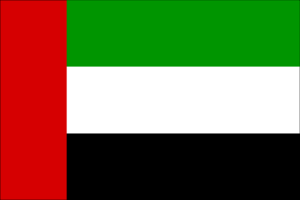United Arab Emirates
The United Arab Emirates is a federation of seven states (Abu Dhabi, Ajman, Dubai, Fujeirah, Ras al-Khaimah, Sharjah, and Umm al-Quwain). Prior to 1971, these Emirates were known as the Trucial states or Trucial Oman.
The UAE is a Federal constitutional monarchy, with the Emir of Abu Dhabi being the President and the Emir of Dubai being the vice president as well as Prime minister.
The capital of the UAE is Abu Dhabi and the largest city is Dubai. The official language is Arabic.
The economy of the UAE heavily depends on expatriates. Currently, less than 20% of UAE consists of nationals (Emiratis) with the rest being expatriates from other Arab countries, Iran, South Asia, and small minorities from South-East Asia, Russia, Europe, and North America.
History
The U.A.E. was formed from the group of tribally organized Arabian Peninsula Sheikhdoms along the southern coast of the Persian Gulf and the northwestern coast of the Gulf of Oman. This area was converted to Islam in the Seventh century; for centuries it was embroiled in dynastic disputes. It became known as the Pirate Coast as raiders based there harassed foreign shipping, although both European and Arab navies patrolled the area from the 17th century into the 19th century. Early British expeditions to protect the India trade from raiders at Ras al-Khaimah led to campaigns against that headquarters and other harbors along the coast in 1819. The next year, a general peace treaty was signed to which all the principal sheikhs of the coast adhered. Raids continued intermittently until 1835, when the sheikhs agreed not to engage in hostilities at sea. In 1853, they signed a treaty with the United Kingdom, under which the sheikhs (the "Trucial Sheikhdoms") agreed to a "perpetual maritime truce." It was enforced by the United Kingdom, and disputes among sheikhs were referred to the British for settlement.
Primarily in reaction to the ambitions of other European countries, the United Kingdom and the Trucial Sheikhdoms established closer bonds in an 1892 treaty, similar to treaties entered into by the U.K. with other Gulf principalities. The sheikhs agreed not to dispose of any territory except to the United Kingdom and not to enter into relationships with any foreign government other than the United Kingdom without its consent. In return, the British promised to protect the Trucial Coast from all aggression by sea and to help out in case of land attack.
In 1955, the United Kingdom sided with Abu Dhabi in the latter's dispute with Saudi Arabia over the Buraimi Oasis and other territory to the south. A 1974 agreement between Abu Dhabi and Saudi Arabia would have settled the Abu Dhabi-Saudi border dispute; however, the agreement has yet to be ratified by the U.A.E. Government. The border with Oman also remains officially unsettled, but the two governments agreed to delineate the border in May 1999. Since that time, the U.A.E. has constructed a border fence along the entire length with both Oman and Saudi Arabia. The new fence and checkpoints will likely be finished by 2008-2009.
In 1968, the U.K. announced its decision, reaffirmed in March 1971, to end the treaty relationships with the seven Trucial Sheikhdoms which had been, together with Bahrain and Qatar, under British protection. The nine attempted to form a union of Arab emirates, but by mid-1971 they were unable to agree on terms of union, even though the termination date of the British treaty relationship was the end of 1971. Bahrain became independent in August and Qatar in September 1971. When the British-Trucial Sheikhdoms treaty expired on December 1, 1971, they became fully independent. On December 2, 1971, six of them entered into a union called the United Arab Emirates. The seventh, Ras al-Khaimah, joined in early 1972.
The U.A.E. sent forces to help liberate Kuwait during the 1990-91 Gulf War. U.A.E. troops have also participated in peacekeeping missions to Somalia, Lebanon, Bosnia, Albania, Kosovo, and Kuwait.
In 2004, the U.A.E.'s first and only president until that time, Sheikh Zayed bin Sultan Al Nahyan, died. His eldest son Khalifa bin Zayed Al Nahyan succeeded him as Ruler of Abu Dhabi. In accordance with the Constitution, the U.A.E.'s Supreme Council of Rulers elected Khalifa bin Zayed Al Nahyan as U.A.E. Federal President. Mohammed bin Zayed al Nahyan succeeded Khalifa as Crown Prince of Abu Dhabi. In January 2006, Sheikh Makotum bin Rashid Al Maktoum, U.A.E. Vice President and Prime Minister and Ruler of Dubai, passed away and was replaced by his brother, Sheikh Mohammed bin Rashid Al Maktoum (MbR), Ruler of Dubai and U.A.E. Minister of Defense. On February 9, 2006, the U.A.E. announced a cabinet reshuffle. Several ministries were eliminated or renamed, while others were created.[1]
